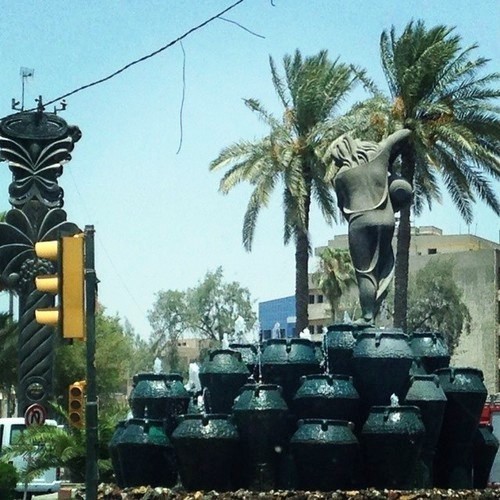Baghdad, the capital city of Iraq, is home to a number of historical landmarks and monuments, each with its own unique story to tell. One such monument is the statue of Kahramana, a symbol of resilience and strength that stands tall in the heart of the city.
The statue is of a beautiful young girl carrying a jar and pouring water down and surrounded by another forty jars around her on the crossroads between the famous Karrada Dakhil (the inner district) and Karrada Kharij (the outer district) in the capital city of Baghdad. Her name is Kahramana. The iconic statue was made during the 1960s, by a famous Iraqi artist named Mohammed Ghani Hikmat.
I go around it when I go to the Iqama office (Department of Residence) in Baghdad. Kahramana fascinates me for many reasons. The fact that it was built five decades ago was a testimony to the talent of all Iraqi artists.

Many people believe that the statue of Kahramana is a statue depicting part of the tale of “Ali Baba and the Forty Thieves” from the One Thousand and One Nights, which is often known in English as the Arabian Nights. The slave girl Morgiana pours boiling oil into storage jars where the thieves are lying in wait to attack her master.

There was a young and smart girl called Kahramana, who used to help her father run a small hotel in old Baghdad. The father used to bring a cart full of empty jars, and the next morning, he filled each jar with oil to sell them in the market.
On a cold winter night, Kahramana heard some noise and later discovered that thieves were hiding in the empty jars. Their heads were only visible to watch. Kahramana went to her father’s room, woke him up, and told him about what she saw. They came up with an idea to make some noise in the hotel so the thieves would hide completely inside the jars.

When this happened, she filled a jar with oil and started pouring the oil on every single jar with a thief hiding in it. The thieves began screaming, and one after the other jumped out of the jars, by the time this happened, the police came and arrested them.
This is the story as it is told in old tales, and it dates back to the pre-Islamic era. Maybe the Ali Baba story was derived from this old folklore.

Kahramana, which means “heroine” in Arabic, is a fitting name for this iconic statue. It represents the courage and determination of the Iraqi people in the face of adversity and serves as a reminder of the sacrifices made by those who fought for their country’s freedom.
Despite being targeted by vandals and terrorists over the years, the statue of Kahramana has stood strong, a testament to the resilience of the Iraqi people. It has become a beloved symbol of national pride and a popular destination for tourists visiting Baghdad.
I don’t think there is any other Arab country that showcases a contemporary work of art depicting a female heroine in the middle of their streets. The statue of Kahramana is more than just a piece of art; it is a powerful symbol of hope and inspiration. It serves as a reminder that even in the darkest of times, there is always hope for a brighter future. As Iraq continues to rebuild and move forward, the statue of Kahramana will remain a beacon of hope for generations to come.


At the first glance to the statue of Kahramana, and reading about the 40 jars, I too thought she was the legendary girl Marjiana. The other story is fascinating as well… 🙂
The post reminded me of the stories of the Arabian Nights…so fascinating they’re…
LikeLiked by 1 person
We all grew up reading stories from Arabian Nights. Some of the stories fascinated me more like the voyages of Sindbad and the ruler Haroon Rashid. May be that drew me to Baghdad. 🙂
LikeLiked by 1 person
বাগ্দাদের খলিফ’র গল্প… 😀 কত পড়েছি…
LikeLiked by 1 person
I will probably never go here so I so appreciate people who do and share their experience!
LikeLike
Thanks Georgia.
LikeLike
I have read the folk tale of Ali Baba and the Forty Thieves and also seen a movie based on it. It is interesting to know that Kahramana could be Morgiana!
LikeLiked by 1 person
Beautiful sculpture and interesting folklore that might have inspired the story of Ali Baba.
LikeLiked by 1 person
बढ़िया मूर्ति और मज़ेदार क़िस्सा .
LikeLiked by 2 people
धन्यवाद!
LikeLike